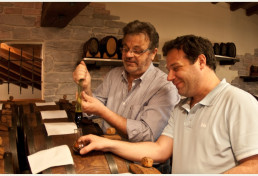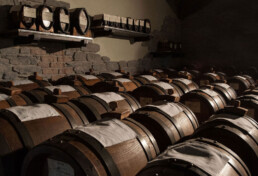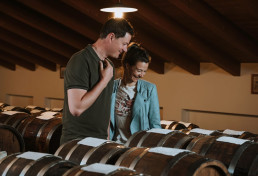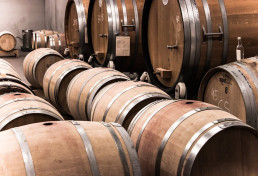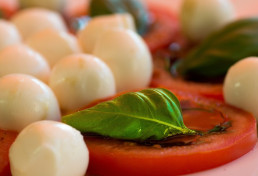What to visit in Modena: our tips
Modena is a beautiful city, rich in history and culture, and we know it well! It has always fascinated its visitors with three irresistible protagonists: art, food and engines. Do you agree? With this in mind, today we want to tell you about some of the wonders of our territory: what to visit in Modena? From squares to museums, from palaces to unique gastronomic traditions, we will take you on a journey to discover some of the secrets of our city and the most beautiful places to admire.
Piazza Grande: the artistic heart of Modena
In 1997, Piazza Grande was awarded the title of World Heritage Site by UNESCO, confirming its unparalleled beauty.
The Duomo, the Ghirlandina Tower and the Palazzo Comunale form a spectacular backdrop, making this square one of the most fascinating in the world.
The history of Modena is intertwined with this square, where markets, festivals and other popular events took place.
Still today, but obviously with the characteristics of another era, this location often hosts events of different calibre. Therefore, if you want to know what to visit in Modena, Piazza Grande is one of the stops to mark on your itinerary. Works of art such as the Ringadora Stone add unique value to this interesting square.
The Cathedral of Modena, a masterpiece in the Romanesque style
The architect Lanfranco created a masterpiece of Romanesque architecture in 1099: the Cathedral of Modena. Its sculptures and reliefs tell biblical stories, while the crypt houses the body of St Geminianus, the patron saint of Modena. The Duomo is an extraordinary testimony to medieval art and spirituality in the city, and offers visitors a truly immersive experience in history.
The Ghirlandina Tower and the Town Hall
Next to the Duomo rises majestically the Torre Ghirlandina, the symbol of Modena. This imposing structure was built between 1160 and 1319. The tower houses treasures such as the Stanza dei Torresani and the Cathedral Museum. Its architecture and the history it holds make it a must-see point for those who want to know what to see in Modena.
Still talking about what to visit in Modena, it is worth saying that the Palazzo Comunale is a true 17th-century masterpiece.
In addition to its imposing façade, its interior rooms, such as the Sala del Fuoco and the Sala degli Arazzi, narrate the history and culture of Modena. The Palazzo Comunale is certainly another unmissable place for those who want to get to know our city in depth.
A visit to the Estensi Galleries
The Gallerie Estensi, with their three collections, house an extensive artistic heritage from Modena, Sassuolo and Ferrara. They house works by artists such as Raphael, Correggio and Velázquez. This extraordinary collection offers a journey of art through the centuries and allows visitors to immerse themselves in the beauty of Italian art and beyond.

What to visit in Modena? The Benedictine Abbey of San Pietro
A short distance from the Duomo, the Benedictine Abbey of San Pietro stands like a Renaissance jewel. The works of art inside, such as the frescoes by Girolamo da Vignola, and the Spezieria narrate the rich artistic and cultural history of the city. A visit to this abbey is practically a must for anyone coming to Modena: it allows visitors to step back in time and appreciate the magnificence of Renaissance art.
All the elegance of the Doge's Palace
Those wondering what to visit in Modena certainly have another stop to add to their list: the Palazzo Ducale di Modena. This historic residence is distinguished by its elegant façade and Courtyard of Honour. The interior rooms, such as the Galleria dei Bronzi and the Sala del Trono, convey the opulence and history of the Estense Court. It was in fact the seat of the Duchy of Modena and Reggio between the 17th and 19th centuries. Since the unification of Italy, the Palace has housed the Military Academy of Modena and the Geophysical Observatory of Modena. A visit to the Ducal Palace is a unique opportunity to immerse yourself in the life of the Dukes of Modena of the past and beyond.
Museo Enzo Ferrari: the myth of Italian cars
As you know, Modena is renowned for being the birthplace of prestigious car brands, and the Enzo Ferrari Museum celebrates this legacy. In addition to legendary cars, the museum tells the personal story of Ferrari founder Enzo Ferrari. The interactive exhibits and vintage cars make this museum a paradise for motor fans and a recommended stop for everyone. Indeed, it is very interesting to discover the history of the world-famous flamboyant car and its creator. Isn't it? This museum is certainly a must-see for anyone who wants to know what to visit in Modena.
Modenese cuisine and its unforgettable flavours
In addition to the historical and cultural stops, it is also important to value the Modenese cuisine, which offers a riot of authentic flavours and unique organoleptic experiences. From fresh pastas, such as tortellini and tagliatelle, to local cured meats, each dish reflects the culinary tradition of the region. Cheeses, such as Parmigiano Reggiano, and desserts, such as torta Barozzi, complete the culinary experience within the territory, making it absolutely unforgettable. Therefore, our advice is this: do not leave Modena without stopping at one of the restaurants offering typical dishes... Otherwise, it will not be a complete visit!
The authentic taste of Traditional Balsamic Vinegar of Modena PDO
Obviously, we have not forgotten balsamic vinegar, also because it is very interesting for those who want to know what to visit in Modena. We have included it last, but not least: only because we will conclude this little voyage of discovery through Modena by recommending the best way to discover how balsamic vinegar is made and taste it just a few steps away from the cask where it has rested before being bottled...
Balsamic Vinegar Production
Modena's culinary tradition is renowned for its Traditional Balsamic Vinegar. This Black Gold, jealously guarded by expert local producers, is the fruit of an artisanal process that has been handed down for generations, interwoven with passion, patience and skill. Production begins with the very essence of the Emilian land: the grape. Two grape varieties, Trebbiano and Lambrusco, are carefully selected and harvested when they reach perfect ripeness. These precious fruits are the foundation of a product that requires time and dedication.
The cooking of the must
The must obtained from pressing the grapes is the main ingredient of Traditional Balsamic Vinegar of Modena PDO. This must is cooked for a long time over low heat in wooden cauldrons until it reaches a high density and syrupy consistency. During this delicate cooking phase, the must releases its deepest and most intense aromas, giving the future balsamic vinegar its characteristic profile of sweetness and complexity.
Acetification and ageing
After cooking, the must is transferred to fine wooden barrels, traditionally oak, where the acetification process begins. It is here that the mother of vinegar, a culture of acetic bacteria, does its magic work, slowly transforming the must into vinegar. This process takes place thanks to the oxygen that penetrates through the pores of the barrel wood, allowing the bacteria to perform their transformation task.
But Balsamic is not only the result of fermentation, it is also the fruit of long ageing. Barrels, carefully arranged in attics or cellars, are the essential resources in this maturing process that can last from twelve to over twenty-four years for Traditional Balsamic. During this time, the balsamic vinegar slowly absorbs the flavours and aromas of the wood, developing a unique complexity and depth of flavour that make it a true gastronomic gem. Visiting a local acetaia is the best way to discover the production process and taste authentic Balsamic Vinegar of Modena.
What to visit in Modena: the vinegar cellar guided tour
In short, Modena enchants its visitors with its extraordinary artistic beauty, rich history and excellent culinary tradition. The city is a true gem that combines art, food and engines in a unique experience, and not far from the historic centre you can also find our acetaia, inside which you can see how we make balsamic vinegar. So, if you wanted to know what to visit in Modena, you now have a good itinerary at your fingertips and all you have to do is book a guided tour of the acetaia! You can find more information about our guided tours by clicking QUI.
Balsamic vinegar: a bit of history... and a guided tour of the vinegar cellar afterwards!
The history of balsamic vinegar is deeply linked to the Modena area and has its roots in a centuries-old tradition. The latter, in 2000, led the traditional product to obtain Protected Designation of Origin (PDO) status. In 2009, it allowed the condiment made by adding wine vinegar to cooked must to be included by the European Commission in the register of I.G.P. (Protected Geographical Indication) products. Let's take a look at the main stages of balsamic vinegar, from the past to the present, and how to learn more about them on a guided tour through the vinegar cellar.
The Traces in Ancient Rome
We all know that balsamic vinegar is of Italian origin, but few of us know that the history of this condiment has very ancient origins. We find, in fact, some traces of its production and use as far back as the Middle Eastern civilisations of the 3rd millennium BC and, above all, during the period of the Ancient Romans. It was here that the cooking of grape must was born, typical of the balsamic vinegar production process that can be observed during a guided tour of the vinegar cellar.
Initially, however, must was not used as a condiment. We find evidence of such use in the first book of Virgil's Georgics.
More specifically, it tells of a woman from the Emilian area who used to cook must to put it in barrels and consume it later.
At the court of the Estensi
Over the centuries, the ancestor of balsamic has undergone numerous changes. However, the first concrete evidence of a condiment from the Modena area, similar to balsamic vinegar, dates back to the transfer of the Este family from Ferrara to Modena. In the registers of the Este secret cellars, relating to the year 1747, there is mention of this interesting food and wine product.
The Napoleonic Invasion and the Balsamic Vinegar Trade
.
Until 1796, the year of the Napoleonic invasion, balsamic vinegar was a condiment found only on the tables of the Este dukes. After Napoleon's arrival in Italy, this product began to be known and sold even outside the Duchy of Modena. Producers began to present it at numerous international exhibitions, meeting with great success.
It is also possible to date back to the 19th century the establishment of the first dynasties of producers of balsamic black gold, who are still part of the Consorzio di Tutela today.
Balsamic Vinegar Today
In 1933, balsamic vinegar was officially recognised by the Minister of Agriculture Giacomo Acerbo. It was in 1965, however, that the Official Gazette published the first specification on the ‘Characteristics of composition and method of preparation of Balsamic Vinegar of Modena’. Over time, this condiment has become increasingly popular. It has gained greater appreciation year after year.
Balsamic Vinegar of Modena from Acetaia Marchi and the guided tour of the vinegar cellar
.As we said at the beginning, from the diffusion and appreciation obtained over time, balsamic vinegar has come to obtain some very important recognitions. We at Acetaia Marchi are proud of this and that is why we produce our vinegar by valuing tradition and using top quality grapes. We do not use preservatives or other substances that can alter the authenticity of the dressing.
We only offer products that guarantee a unique and unforgettable culinary experience.
Bring the taste of tradition to the table with Balsamic VinegarTraditional Balsamic Vinegar of Modena D.O.P. and the Balsamic Vinegar of Modena I.G.P. from Acetaia Marchi. Then, do not hesitate to book a guided tour of the acetaia, during which you will discover how this delicious and precious condiment is produced. You certainly won't regret it!
Balsamic vinegar and fish: recommended pairings
Balsamic vinegar, with its rich and complex flavour, is a versatile condiment that can turn even the simplest fish dish into an extraordinary culinary experience. However, combining balsamic vinegar and fish requires some care to ensure that the flavours harmonise at their best. With this in mind, here are some tips to help you understand how best to combine these two delicious ingredients.
Smoked Salmon and Traditional Balsamic Vinegar of Modena PDO
The rich, smoky flavour of the salmon marries beautifully with the acidity and sweetness of the Traditional Balsamic Vinegar of Modena PDO. A light splash of balsamic on the slice of smoked salmon can highlight the flavours without covering them, creating a harmony between the intense taste of the fish and the balsamic acidity.

Balsamic vinegar and fish: let's try grilled sea bass
The grilled sea bass is an elegant and delicate dish. To accentuate its flavour, you can prepare a balsamic vinegar reduction. Simply cook the balsamic vinegar in a pan and turn off the heat as soon as the sauce thickens slightly. You can pour this reduction over the grilled sea bass and achieve an irresistible combination of balsamic vinegar and fish!
Tuna carpaccio with balsamic vinegar and citrus fruit sauce
Fresh, raw tuna is an excellent base for those who want to experiment with balsamic vinegar. Prepare a light sauce by mixing balsamic vinegar with a little fresh citrus fruit juice, olive oil and a pinch of salt. Pour this sauce over the tuna carpaccio: you will create a fresh and tasty dish, balanced and full of flavour contrasts.
Grilled squid with balsamic vinegar marinade
Grilled squid is a light and tasty delicacy. To intensify their flavour, you can marinate the squid with a mixture of balsamic vinegar, olive oil, garlic and herbs. Let the squid soak up this marinade before grilling them. You will get a balsamic vinegar and fish dish rich in aromas and heady Mediterranean flavours.
Seafood Salad with Vinaigrette
Seafood salad is already delicious and can become nothing short of extraordinary with a balsamic vinegar vinaigrette. Mix balsamic vinegar with olive oil, mustard, garlic and parsley: this special vinaigrette will delicately envelop the seafood, giving it a hint of acidity and complexity that will win over even the most discerning palates.
Balsamic vinegar and fish? Give it a try!
Balsamic vinegar can be a valuable ally in enhancing the flavours of fish, but of course it is all a matter of taste! Experiment with these recommended combinations and be surprised at how the unique aroma of balsamic vinegar can transform your fish dish into a memorable gastronomic experience.
Our advice is to try several combinations of balsamic vinegar and fish, even using different types of balsamic. You can find plenty of quality options in our online shop and also in our Balsamic Shop located just a stone's throw from our vinegar cellar. We are waiting for you to offer our best products and to give you further advice on food pairings.
4 things you (may) not know about balsamic vinegar
The balsamic vinegar is a condiment with a rich and complex flavour that has deep roots in the Italian culinary tradition. But how many of us really know everything there is to know about this precious liquid? Here are four things you may not know about Oro Nero di Modena.
1. The long ageing process
While many condiments are ready for immediate use, balsamic is a product that takes time to be ready. Its production is an artisanal process that can take up to decades! The grapes, usually Trebbiano or Lambrusco, are pressed and the must obtained is slowly cooked for hours. Subsequently, the vinegar is aged in wooden barrels, often made of oak or chestnut. Some high-quality traditional balsamic vinegars may even have been aged for 25 or 50 years. This prolonged ageing allows the balsamic vinegar to develop a more complex flavour and a thick, syrupy consistency.
2. The PDO (Protected Designation of Origin) Label of Traditional Balsamic Vinegar of Modena
When you buy a bottle of traditional balsamic vinegar, you are faced with the DOP label. This acronym stands for 'Denominazione di Origine Protetta' (Protected Designation of Origin) and is a quality mark recognised throughout Europe. The PDO label guarantees that the balsamic vinegar has been produced in a traditional and authentic way, following strict quality standards and coming from a specific Italian territory, namely Modena.
3. The Art of Aging
The ageing of balsamic vinegar is a true art. While Balsamic Vinegar of Modena PGI must age for at least 60 days, Traditional must age for at least 12 years. During this long period, the barrels are opened to let air in, thus stimulating the oxidation process and developing the characteristic aroma and flavour of the balsamic. Barrels of different woods and in different sizes are also used: periodically transpassing into smaller barrels, without adding any aromatic substances. These practices require great skill and experience: it is necessary to be able to find the perfect balance between the desired ageing and exposure to air.

Do you want to know more about balsamic vinegar?
As you have seen (and as you certainly already know, if you have tasted it), balsamic vinegar is much more than just a condiment: it is a testament to Italian culinary tradition and art. The next time you pour it on your salad or use it to marinate meat, remember these curiosities that make this condiment so unique and fascinating...
If you would like to find out more and see for yourself how it is prepared, all you have to do is book a visit to the vinegar cellar. You can find more information directly here.
Seasonal flavors: winter vegetables and Balsamic Vinegar of Modena IGP
Winter is a season full of robust and nutritious flavors, and seasonal vegetables play a crucial role in creating delicious and healthy dishes. Among the gems of the earth that thrive during this time are some winter vegetables that bring with them a wealth of flavor and essential nutrition.An ideal companion to enhance these flavors is Aceto Balsamico di Modena IGP with its aromatic complexity and distinctive character.
But what are the most excellent and must-try pairings as soon as possible?
Discovering winter vegetables
With its dark, almost leathery leaf, the black cabbage is a winter treat that reaches its sweetest after the first frost. It can be steamed and then seasoned with balsamic vinegar to add a tart note and balance its robustness. Similar to potatoes, topinambur is also a treat not to be missed. It is rich in flavor and can be baked in the oven. Balsamic Vinegar of Modena IGP, with its sweetness and acidity, adds depth to the flavor of this tuber, making it possible to create a delicious winter dish.
The purple cauliflower is another of the vegetables enjoyed in winter and is certainly one of the most popular. It boasts an eye-catching color and is a food rich in antioxidants. It can be marinated with balsamic and then baked in the oven.... It will turn into a definitely tasty side dish! The same is true for fennel, which is fresh and crisp, making it a versatile food even in winter.
Cut into thin slices and dressed with a balsamic-based vinaigrette, it will look like a light and refreshing salad.
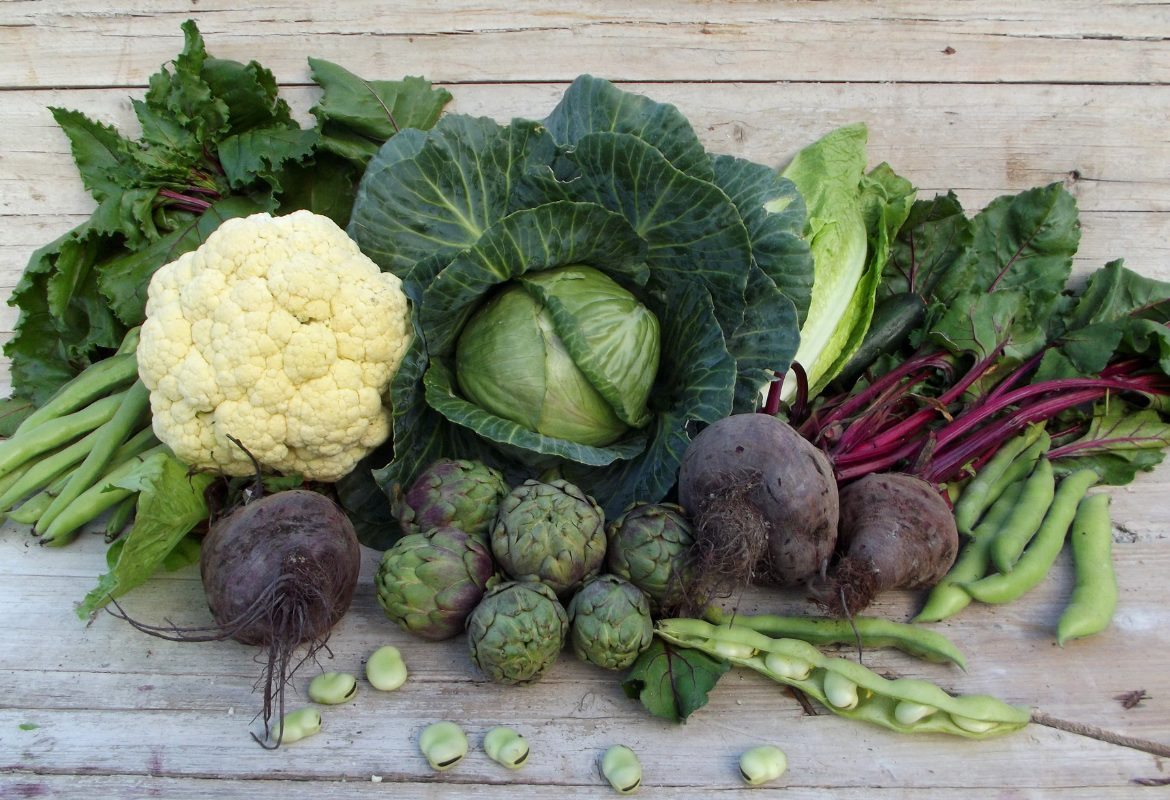
Other food pairings with Balsamic Vinegar of Modena IGP
Below you will find some dishes to try during the colder months of the year and beyond.
- Balsamic Beet Salad - Winter beets, baked and sliced, go perfectly with balsamic vinegar. Adding toasted walnuts and goat cheese will bring a winter salad to the table that is nothing short of refined.
- Baked Pumpkin with Balsamic Vinegar of Modena IGP Reduction - Slices of pumpkin, roasted in the oven, can be flavored with a balsamic reduction. This dish boasts an irresistible sweet-and-sour flavor.
- Cabbage sautéed with balsamic - To prepare this dish one must sauté cabbage with garlic and olive oil. At the end of cooking, a few drops of balsamic are added, which will be able to make the cabbage even tastier.
- Mash of Jerusalem artichokes with balsamic drops - Jerusalem artichoke puree becomes even more extraordinary with the addition of a few drops of balsamic that accentuate the creaminess and add a touch of acidity to the dish.
All the goodness of Balsamic Vinegar of Modena IGP on the table with winter vegetables
In this brief journey through the pairings of winter vegetables and balsamic vinegar, we have certainly given you some insights that will lead you to prepare amazing dishes. The Balsamic Vinegar of Modena IGP, with its versatility, proves to be a valuable ally in elevating winter flavors to new heights of gastronomic delight. You can find quality balsamic directly at our Bottega just minutes from the historic center of Modena. We are waiting for you!
A rejuvenating experience, from walking among the vines to visiting the vinegar cellar
Immersed in the daily hustle and bustle, we often forget the healing power that can come from connecting with nature and traditions. With these assumptions in mind, today we invite you to join us on a unique journey and enjoy a rejuvenating experience that goes beyond a simple walk among the vines and will end with
A visit to the vinegar cellar. We will discover a world of aromas, flavors and stories intertwined among the green hills of vineyards and ancient vinegar cellars. We will tell you about an experience that can not only satisfy the senses but also regenerate body and soul.
The walk through the vineyards of the province of Modena
The experience begins with an immersion in the tranquil landscape of a vineyard.
According to a study conducted by Harvard Medical School, walking in nature not only reduces stress, but can also improve concentration and mood. Of course, however, our main purpose is not only to make you relax, but to tell you how balsamic vinegar is created. Precisely for this reason, before moving on to a visit to the vinegar cellar, we take our guests to our own vineyards.
It is in these lands that the raw material from which we make balsamic is born, and it is here that we will begin to tell you how we work, not forgetting anecdotes and important pieces of history.
The next step: from grapes to a visit to the vinegar cellar
From the vineyard, we will move to the our vinegar cellar. It is a place where tradition reigns, where the art of turning grapes into cooked must and then into balsamic vinegar has been handed down for generations and generations.
Balsamic vinegar is not only a condiment, but also a concentration of health benefits: it contains antioxidants and compounds that can help improve digestion.
We will tell you about the craftsmanship, show you the steps of production and our fine barrels, and also tell you about all the organoleptic and nutritional characteristics of our balsamic.
The ritual of tasting
Every self-respecting visit to a vinegar cellar ends with a ritual as old as it is modern: the tasting of balsamic vinegar. We do this during production, to ensure that ours are always vinegars of quality. You will be able to taste Traditional Balsamic Vinegar of Modena DOP and Balsamic Vinegar of Modena IGP to discover with your sense of taste what characteristics make these products true Italian excellences. Thanks to the degustation you can learn about all the organoleptic nuances of Modena's Black Gold.

A visit to the vinegar cellar that becomes a rejuvenating experience!
In conclusion, we can say one thing: this experience will prove to be not just an escape from routine, but a rejuvenating organoleptic journey. The scent of grapes, that of cooked must and ready-made balsamic and the heady flavors of this condiment will be joined by a mix of history, science and tradition. We at Acetaia Marchi are ready to guide you through a journey that goes beyond just sightseeing in the area.
A visit to acetaia is a unique, engaging and rejuvenating experience. In a fast-paced world, taking the time to rediscover the wonderful traditions of the Modena area is definitely a very good idea! You can find more details and book avisit to our acetaia by clicking QUI.
Balsamic Vinegar of Modena IGP or Traditional DOP? Tips for cooking
When it comes to choosing between Balsamic Vinegar of Modena PGI (Protected Geographical Indication) and Traditional Balsamic Vinegar of Modena PDO (Protected Designation of Origin), the options can seem abundant and complex. In this guide we are going to see what the main differences between the two are and offer some tips for use in the kitchen.
Balsamic Vinegar of Modena IGP: a versatile ally
Balsamic Vinegar of Modena IGP is a versatile choice as well as ideal for everyday use in the kitchen. Made primarily from cooked grape must and wine vinegar, and aged in wooden barrels, the PGI is known for its balance of acidity and sweetness. Its production follows certain procedures that ensure remarkable and appreciable quality from a taste point of view and beyond.
How to use it in cooking
Being versatile and suitable for everyday use, you can use this seasoning to elevate the flavors of many dishes. Below is a list from which to take inspiration:
- Mixed salads and grilled vegetables - Balsamic Vinegar of Modena IGP is a perfect accompaniment to mixed salads and grilled vegetables. Its balanced flavor adds a delicious sweet and sour note to any dish.
- Cheeses -It proves perfect on aged cheeses such as parmesan or pecorino. It allows you to create more colorful cutting boards and offer guests a sophisticated and special combination of flavors.
- Marinades for meat - IGP makes an excellent base for meat marinades. Its mild acidity and complementary sweetness impart flavor without overpowering the taste of the meat.
- Primi piatti - Particularly in risotti, IGP balsamic presents itself as an outstanding ingredient.
Traditional Balsamic Vinegar of Modena DOP: elegance and tradition
The Traditional Balsamic Vinegar of Modena DOP is also the result of artisanal and traditional production. Sourced from cooked must and aged in fine wooden barrels (for many years longer than the other type of balsamic), this vinegar is characterized by greater density and a more full-bodied and complex flavor than Balsamic Vinegar of Modena IGP. Its production is strictly regulated, guaranteeing consumers a high-quality product.
How to use it in cooking
Given its characteristics, Traditional DOP proves perfect for more refined dishes and even gourmet dishes. It is excellent on grilled meat and fish and even on carpaccio. Its aromatic complexity adds flavor to the dish and offers a unique organoleptic experience. This balsamic is also suitable for pairing with fruit (especially on strawberries) and with ice cream. It is also ideal with fine cheeses such as gorgonzola and taleggio cheese.

Some practical tips for using Aceto Balsamico di Modena IGP and Aceto Balsamico Tradizionale di Modena DOP
Whatever the dish to be enhanced, it is important to consider that both vinegars have intense flavors. So it is advisable to use them in moderation: you can start with a few drops and add more gradually according to your tastes. Doing so will not risk overpowering the other flavors, but will only enhance them. It should also be remembered that everyone has their own culinary preferences. Therefore, it is a good idea to experiment with different combinations until you find the ideal pairings for your palate.
Finally, do not forget to invest in high-quality vinegars made by producers who follow traditional techniques passed down from generation to generation. The quality of the ingredients will be reflected in the end result, and thus in the taste and texture of the dish. You can find Traditional Balsamic Vinegar of Modena IGP and Traditional Balsamic Vinegar of Modena DOP directly in our Bottega, located a short distance from the center of Modena. We look forward to welcoming you
5 tips for recognizing authentic balsamic vinegar
Balsamic vinegar, with its rich flavor and characteristic enveloping aroma, is a culinary treasure beloved around the world. However, the market is often saturated with counterfeit or diluted products. This makes the ability to recognize the authenticity of this prized elixir crucial. With that in mind, here are five tips that can help you recognize authentic balsamic vinegar from low-quality imitations.
1. Always read the label carefully
The first step is always this: read the label very carefully. A true balsamic vinegar will bear the indication "D.O.P." (Protected Designation of Origin) or "P.G.I." (Protected Geographical Indication). In addition to the wording, it is useful to know that producers of Traditional Balsamic Vinegar of Modena PDO must place a specific stamp on the bottle. Balsamic Vinegar of Modena PGI also features the characteristic yellow and blue stamp.
All of these elements are synonymous with quality and authenticity: they help to recognize authentic balsamic vinegar and guarantee that the product was made in and around Modena, following special processes and techniques handed down from generation to generation.
2. Check the quality of the container and cap
Traditional Balsamic Vinegar of Modena PDO is always sold in a spherical-shaped bottle with a rectangular base made of solid white glass that can hold 100 ml of product. The stopper, however, must be expertly sealed.
3. Examining the density and consistency of the product helps to recognize authentic balsamic vinegar
Authentic balsamic vinegar is known for its substantial texture and its particular density, which is more pronounced in Aceto Balsamico Tradizionale di Modena POD and less pronounced in PGI. These characteristics can be checked by tilting the bottle slightly. If the vinegar slides slowly down the walls of the container, rather than flowing rapidly, it is likely to be of high quality. The fuller consistency is the result of years of aging and concentration of the product.

4. Tasting always makes a difference
An important test of authenticity is precisely the tasting: high-quality balsamic vinegar offers a complexity of flavors, including sweetness, acidity, and some special flavor notes triggered by aging inside wooden barrels. Cheap imitations may lack this richness of nuance. Therefore, to recognize authentic balsamic vinegar, it is always a good solution to taste the products carefully, looking for the balance between sweet and sour and a lingering aftertaste.
5. Aging and its importance
Time is a key element in the production of balsamic vinegar. For this very reason, when you want to buy this product, it is important to check its age. The aging of Traditional Balsamic Vinegar of Modena PDO can even exceed twenty years! A label that mentions the age of the product is a positive indicator of authenticity.
How to recognize authentic balsamic vinegar? The solution is to trust the producers
Distinguishing the authenticity of this product may seem like a challenge, but with a little care and awareness, you can bring the excellence of an extraordinary condiment to the table. Choose wisely, appreciate the complexity of flavors and enjoy the authenticity of balsamic vinegar that will enrich your dishes with a touch of Italian tradition. To see the stages of production up close, learn how to recognize authentic balsamic vinegar and taste the different types, you can come to our Acetaia. A guided tour can clarify your ideas and offer you an experience whose protagonist is a tradition handed down from generation to generation.
Balsamic vinegar production: discovering the vinegar cellar
Balsamic vinegar is one of Italy's gastronomic treasures and represents a culinary tradition rich in history and passion. It is produced in special places called "acetaie," where the vinegar is carefully produced and aged. In this article we will explore the art behind the production of balsamic vinegar and we will find out what makes vinegar factories so unique.
The Origin of Modena's Black Gold
Traditional Balsamic Vinegar of Modena DOP and Balsamic Vinegar of Modena IGP are products originating in Emilia-Romagna. Their story has its roots In antiquity (OF DOP ONLY) and has become a distinctive tradition especially in the Modena area. Also called Black Gold, to highlight its prestige and a characteristic of its appearance (it has a very dark color), this condiment is now appreciated in every part of Italy and also in many other places in the rest of the world.
The production of balsamic vinegar is regulated by various procedures and directions, and characterized by methods handed down from generation to generation.
The main ingredient is grape must, known as cooked must, which is aged in wooden barrels.
The Vinegar Works: a place that encompasses passion and tradition, fundamental to the production of balsamic vinegar
Acetaie are the places where Traditional Balsamic Vinegar of Modena DOP is produced and refined and/or aged. These facilities are often run by families who have guarded the tradition of this precious condiment for generations. A visit to a vinegar factory is a unique experience that offers a window into the history and culture associated with this precious condiment.
Inside a vinegar cellar it is possible to admire the various stages of production of Traditional Balsamic Vinegar of Modena DOP.
This long and complex process begins with the grape harvest which must be ripe, of high quality and local varieties (from the Modena area) such as Lambrusco o Ancellotta. Next, the grapes are crushed and the resulting must is simmered for hours. This process reduces the must to a very thick syrup known precisely as cooked must. The latter is fermented in wooden barrels... This is the starting point for the "birth" of balsamic vinegar.
The immature vinegar is slowly transferred to a series of smaller and smaller wooden barrels. Each barrel can be made from a different wood, such as cherry, oak, mulberry or chestnut, and imparts unique aromas and flavors to the dressing. Traditional Balsamic Vinegar of Modena DOP must age for at least 12 years. During this time, the vinegar thickens and develops its characteristic sweet-and-sour flavor.
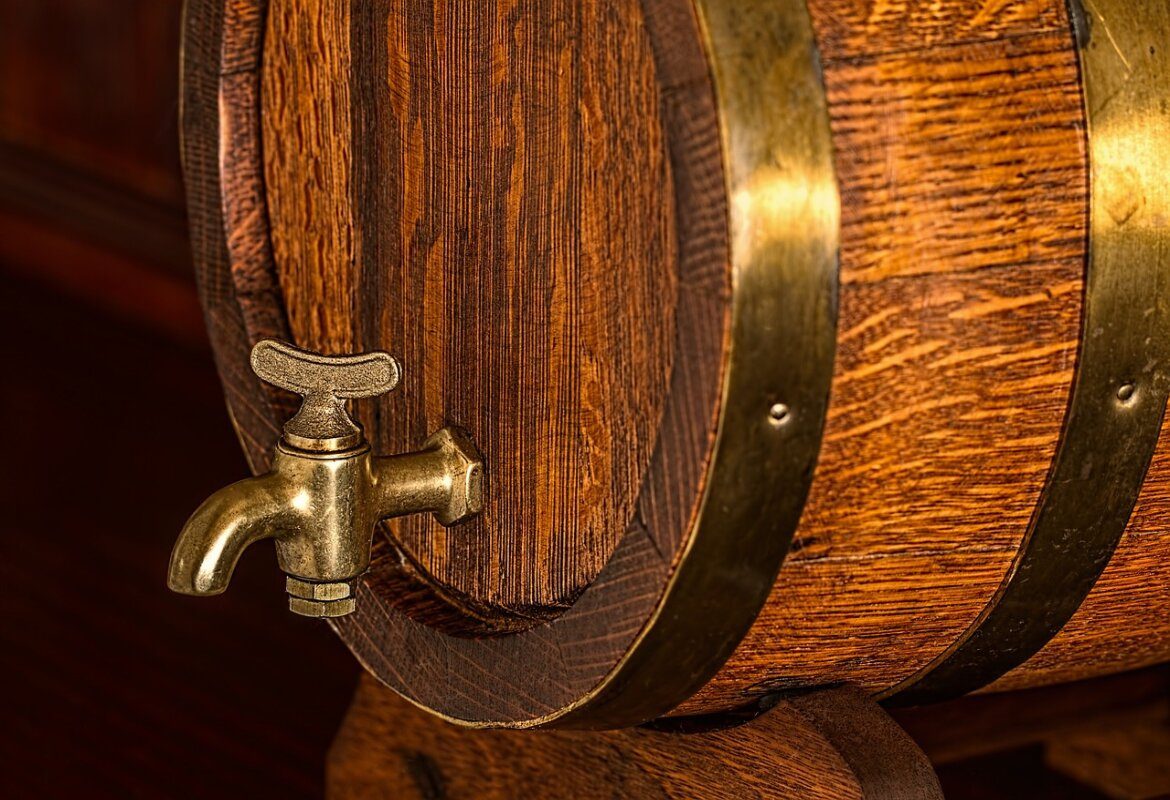
Tasting in the vinegar cellar
Inside a aceteria you can not only see how the production of balsamic vinegar takes place: you can also taste this delicious condiment. You will be able to taste the difference between Balsamic Vinegar of Modena IGP, with its sweet and sour taste, and between Traditional Balsamic Vinegar of Modena DOP
Affinato ( at least 12 years) and Extra old
( at least 25 years). Boasts a rich, complex and velvety flavor.
Balsamic vinegar production in our vinegar factory
Se desiderate visitare un’acetaia, potete venire nella nostra. All’interno dell’Acetaia Marchi you will see with your own eyes how the production of balsamic vinegar.
You will discover that this product is more than just a condiment: it is a culinary tradition passed down from generation to generation, as well as a gastronomic treasure to be enjoyed and appreciated.
The difference between balsamic condiments and balsamic vinegar glaze
Balsamic vinegar is an ingredient loved worldwide for its unique and complex flavor, and so are balsamic condiments and balsamic vinegar glaze. These are highly valued products that boast different characteristics. What are the differences that should not be underestimated? Knowing them can help you make the ideal choice for your preparations.
Balsamic dressing is a versatile ally for flavoring salads and vegetables (also meat, fish and desserts)
Balsamic dressing is a vinegar-based product that is often used as a dressing for salads, vegetables, and cold dishes. Since it is a very versatile condiment, it can be included in a variety of recipes-from making a simple vinaigrette for salads to more complex dishes such as risottos and soups. It has a fluid consistency, similar to balsamic vinegar, and can be drizzled or poured directly over food.
The best quality balsamic seasonings have a balanced flavor that comes across as a perfect blend of sweetness and acidity. They are made with a few first-rate ingredients: concentrated must from local grapes and wine vinegar. After that, they are aged in ancient barrels made of various fine woods. This aging sets in motion the process of acetic fermentation that will create an explosion of flavors.
Balsamic vinegar glaze: what it is and how it differs from balsamic condiments
Balsamic glaze is a thick, syrupy, reduced version of balsamic vinegar. Other foods such as flour, sugar, butter and starches are added to this ingredient. This is definitely the main difference between icing and balsamic condiments: the ingredients change everything, from quality to taste. They give rise to a thick, syrupy consistency that makes frosting a more industrial product, to be used especially for decorating dishes and culinary creations of various kinds.

Glaze or seasoning?
When making the choice, it is important to consider that frostings look like a more industrial product, and therefore of lower quality. Our Balsamic Dressings, on the other hand, are natural and genuine products: a true "mix" of IGP and DOP, and during production they are decanted into different wooden barrels and capacities just as they are for Traditional Balsamic Vinegar of Modena DOP. Thanks to our artisanal techniques, we are able to come up with qualitative seasonings that are very dense, valuable and tasty.
Our range of Balsamic Dressings is designed for those who love the "sweeter" and less acetate-like flavors, but still authentic and non-industrial. You can find all of our products QUI.
Balsamic condiments and other products: our craft production
In summary, the main difference between balsamic dressing and balsamic vinegar glaze lies in the ingredients that characterize their textures, flavors, quality, and culinary uses. Balsamic dressing is a versatile qualitative companion for salads, hot and cold dishes.(Not only that) To learn more about the production of the balsamic condiments and balsamic products, you can book a visit in our Acetaia. You can see what techniques are used and the precious barrels, passed down from generation to generation, that preserve our Balsamic Vinegar throughout the aging period. At this page you can view more information about the different types of visits, durations, and how to make reservations. We look forward


